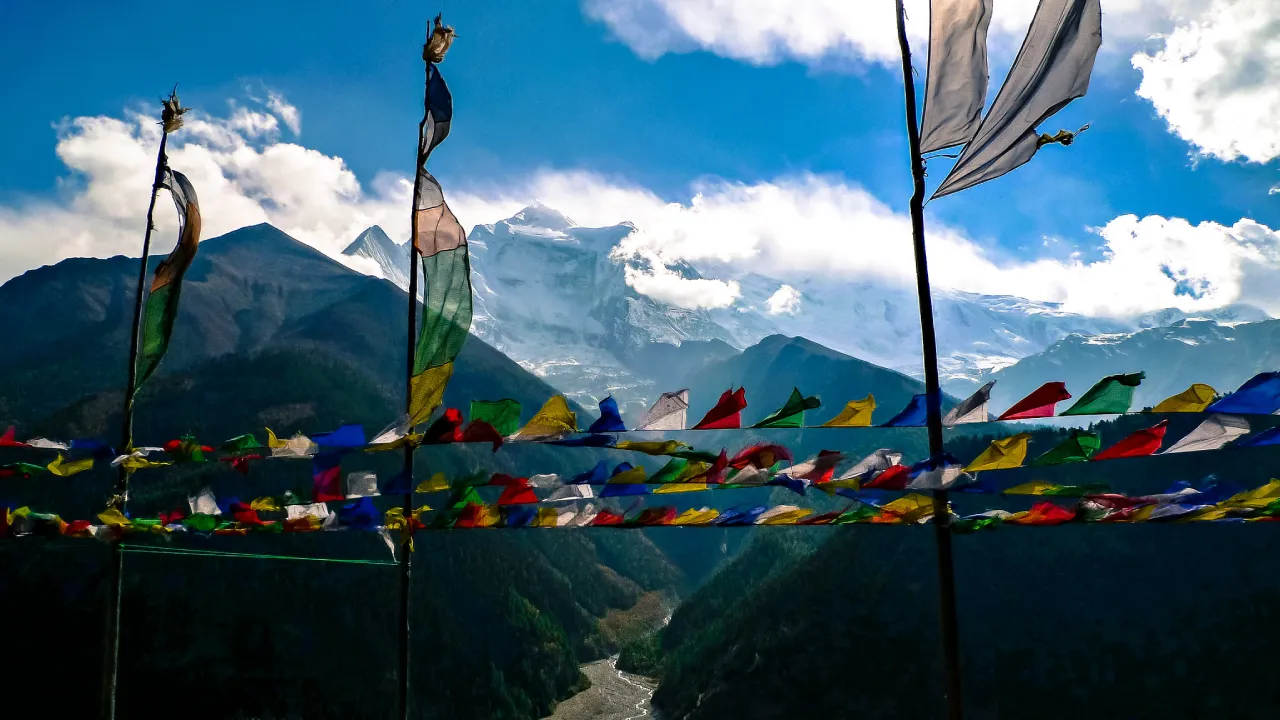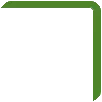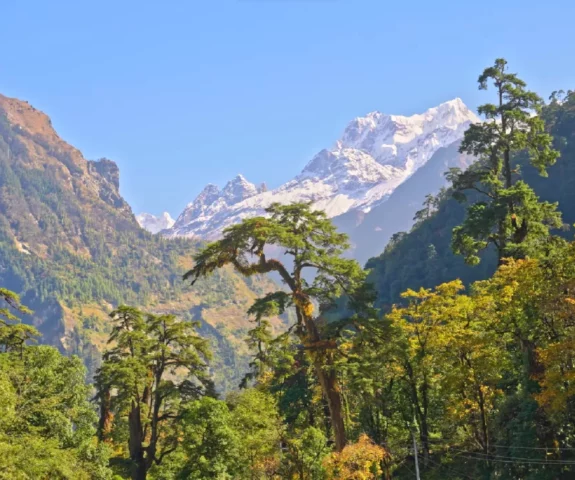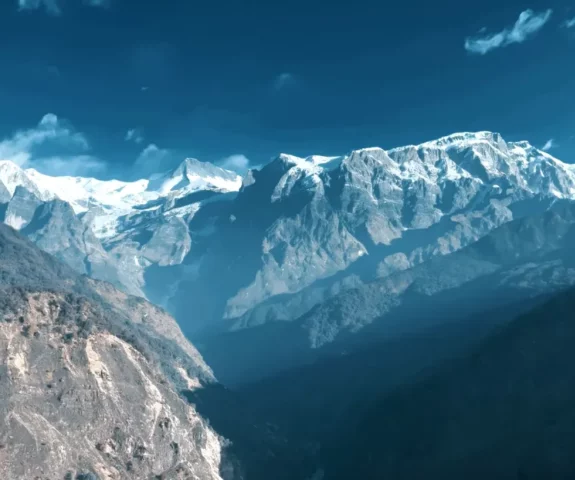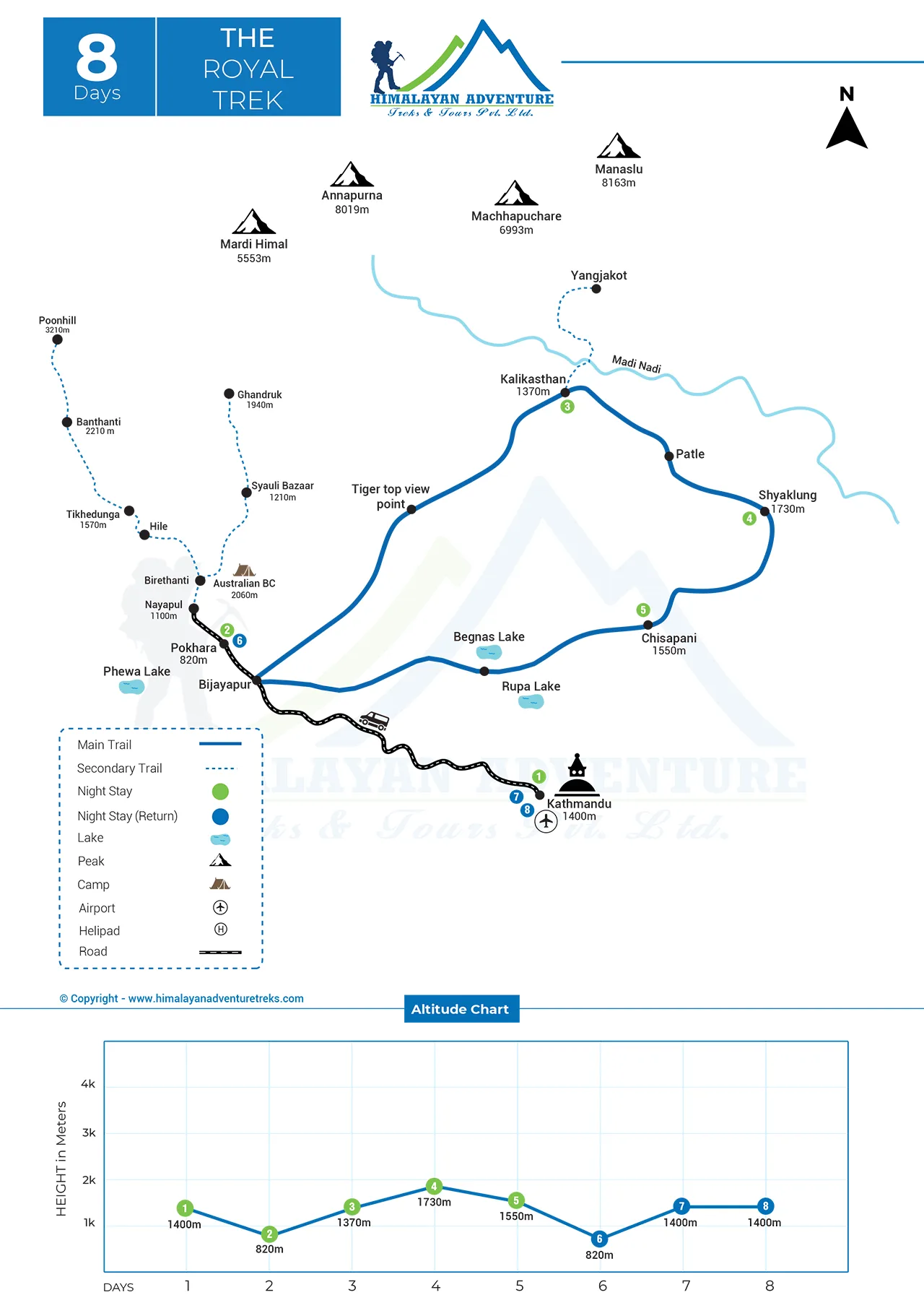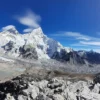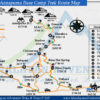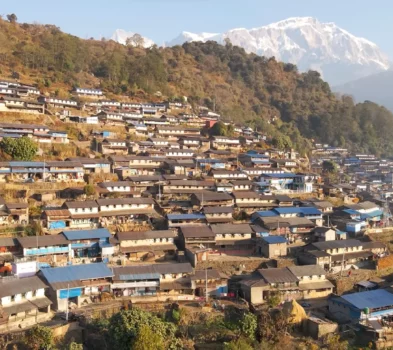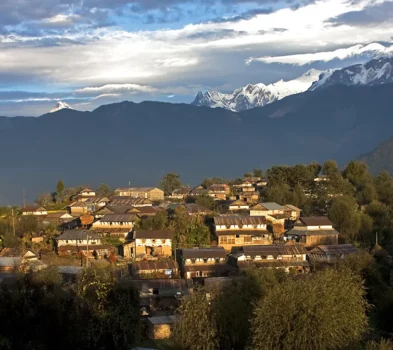Duration
8 DaysThe Royal Trek
Trip Grade
EasyGroup Size
1-16 PeopleMax Altitude
1,730m. / 5,676ft.Best Season
Feb- May/ Sept- NovActivity
Trekkling & HikingMeals
Breakfast, Lunch & DinnerAccommodation
Hotels & TeahousesTransportation
Private Vehicle & BusTrip Customization
On request (click here)Highlights of The Royal Trek
- Breathtaking Mountain Views: Enjoy stunning vistas of towering 8,000-meter peaks like Dhaulagiri and Manaslu, offering unforgettable panoramic views.
- Scenic Lake Views: Witness the mesmerizing beauty of Nepal’s third largest lake, providing serene and picturesque landscapes along the trekking route.
- Easy and Budget-Friendly Trek: Experience an accessible and affordable trekking adventure suitable for all fitness levels, making it an ideal choice for budget-conscious travelers.
- Gurung Village Exploration: Immerse yourself in the rich culture and traditions of the Gurung ethnic community as you trek through their villages, gaining insights into their way of life.
- Less Crowded Route: Escape the crowds and enjoy a quieter trekking experience along this less-traveled route, allowing for a more peaceful and authentic Himalayan adventure.
- Himalayan Adventures: Embark on a thrilling journey through the Annapurna region, known for its diverse landscapes, rugged terrain, and abundant natural beauty.
- Annapurna Circuit: Trek along sections of the famous Annapurna Circuit, encountering varied terrain, charming villages, and breathtaking mountain panoramas.
- Cultural Encounters: Interact with local villagers along the way, learning about their customs, traditions, and daily lives, enhancing your cultural experience.
- Nature Photography: Capture stunning photographs of the Himalayan landscapes, pristine lakes, colorful flora, and diverse wildlife found throughout the trek.
- Memorable Experiences: Create lasting memories as you trek through the spectacular Himalayan scenery, forging friendships, and experiencing the warmth and hospitality of the Nepalese people.
Trip Introduction
The dazzling Royal Trek remains one of the shortest treks in Nepal. The trail goes around the foothills of majestic Annapurna. It is situated north of Pokhara. The Royal Trek involves trekking along with bushy ways among mesmerizing forests. Moreover, the crisp air under blue skies radiates positive energy into any trekker’s mood. Prince Charles once explored the same route with his 90-person staff in 1980. Hence, the trail earned the title of “The Royal Trek.”
Imagine the prettiest pathways surrounded by tall trees and enchanting greens. That’s the Royal Trek for you. The trail goes up to viewpoints where one can enjoy views of Annapurna. Additionally, trekkers love the scenic beauty of Dhaulagiri and Machhapuchhre. Similarly, the trail leads to ethnic villages with preserved traditions.
First of all, the flavorful trek begins with the trek to Kalikasthan (1370m) from Bijayapur. Trekkers stay in Gurung villages. The people are very hospitable. Gurung people are known for their bravery in Nepal. The trek goes up to the beautiful village of Syaklung (1730m). Also, if lucky, a trekker can sport the Manaslu massif from here. Finally, Chisapani (1550m) leads to Begnas Lake.
Trekkers need no prior experience for the Royal Trek. Anyone can attempt easy hiking. Each day consists of only 4-5 hours of walking. Trekkers with kids or the elderly also prefer this trek.
Himalayan Adventure Treks remains invested in providing the safest trips for the clients. The local guides speak English fluently. Additionally, they also provide guides fluent in other languages. They handle everything from food, lodging, logistics, and even inquiries. Thus, they surpass in good customer service.
Outline Itinerary of The Royal Trek
Day 01: Arrival at Kathmandu Airport.
Day 02: Drive from Kathmandu to Pokhara (915m).
Day 03: Drive from Pokhara to Bijayapur and trek to Kalikasthan (1370m).
Day 04: Trek from Kalikasthan to Syaklung (1730m).
Day 05: Trek from Syaklung to Chisapani (1550m).
Day 06: Trek from Chisapani to Begnas Tal and drive to Pokhara.
Day 07: Drive from Pokhara to Kathmandu.
Day 08: Departure to Kathmandu Airport.
Our guests sharing their experiences (Photo/Video Gallery)
Detail itinerary of The Royal Trek
Day 01: Arrival at Kathmandu Airport.
In the evening, you’ll have the opportunity to meet fellow participants and members of the trekking team, fostering camaraderie and excitement for the journey ahead.
Your overnight stay at a hotel in Kathmandu offers comfort and relaxation, preparing you for the thrilling experiences that await in the Himalayas.
Activity: Airport Pickup, 30 min
Max. Altitude: 1,400m/4,593ft. Kathmandu
Accommodation: Hotel
Day 02: Drive from Kathmandu to Pokhara (915m).
While the road from Kathmandu to Pokhara is mostly well-paved, there are some rugged and winding segments, encouraging travelers to proceed at a leisurely pace and relish the picturesque landscapes. En route, there are opportunities to pause at various points of interest, including the revered Manakamana Temple, dedicated to the goddess Bhagwati, offering spiritual solace amidst breathtaking surroundings.
Upon arrival in Pokhara, adventurers are greeted by a bustling city renowned as a haven for outdoor enthusiasts. Whether one seeks trekking expeditions, rafting adventures, or tranquil moments to absorb the surrounding beauty, Pokhara caters to diverse interests. So, sit back, savor the journey, and prepare to immerse yourself in the wonders of this enchanting city.
As evening descends, indulge in the serene beauty of Phewa Lake with a tranquil boating excursion and pay a visit to the enchanting Tal Barahi Temple, nestled on its picturesque island.
Activity: Drive, 6-7 hours
Max. Altitude: 800m/2,625ft. Pokhara
Meal: Breakfast
Accommodation: Hotel
Day 03: Drive from Pokhara to Bijayapur and trek to Kalikasthan (1370m).
Today, you embark on a memorable journey from Pokhara to Bijayapur, followed by an exhilarating trek to Kalikasthan. The picturesque drive from Pokhara to Bijayapur spans 1 to 2 hours, offering scenic vistas of rural villages and rolling hills.
Upon reaching Bijayapur, the starting point of your trek to Kalikasthan, you’ll commence your hike. This 4 to 5-hour trek is relatively gentle, winding through lush forests and along tranquil ridges. Along the way, you’ll be treated to breathtaking views of the majestic Annapurna and Dhaulagiri ranges, providing a captivating introduction to Nepal’s awe-inspiring natural beauty.
Nestled amidst the hills above Bijayapur, Kalikasthan awaits with its charming simplicity. Here, you’ll find modest accommodations and the opportunity to immerse yourself in local life and culture. After a day of travel and trekking, a restful night in Kalikasthan promises rejuvenation, ensuring you’re refreshed and ready to continue your journey come dawn.
Activity: Drive & Trek, 4-5 hours
Max. Altitude: 1,370m/4,495ft. Kalikasthan
Meal: Breakfast, Lunch & Dinner
Accommodation: Teahouse
Day 04: Trek from Kalikasthan to Syaklung (1730m).
Today’s itinerary continues your trek from Kalikasthan to Syaklung, delving deeper into the lush, rolling hills of rural Nepal. This 5 to 6-hour trek immerses you in the natural beauty of the region while offering glimpses into the traditional rural lifestyle.
The well-trodden trail from Kalikasthan to Syaklung meanders through verdant forests and along scenic ridges, treating you to breathtaking views of the surrounding mountains and valleys. Along the way, encounters with local villagers and their livestock provide insight into the authentic rural culture of the area.
Syaklung, perched above Kalikasthan, welcomes you with its serene ambiance. Here, basic accommodations await, allowing you to unwind and experience the warmth of local hospitality. After a day of trekking, a peaceful night’s rest in Syaklung prepares you for the adventures that lie ahead.
As you embark on this trek, remember to stay hydrated, take breaks as needed, and pace yourself to ensure an enjoyable journey. Despite the physical demands of trekking at high altitudes, the stunning scenery and cultural richness of the Kalikasthan to Syaklung trail promise an unforgettable experience that will leave a lasting impression.
Activity: Trek, 5-6 hours
Max. Altitude: 1,730m/5,676ft. Syaklung
Meal: Breakfast, Lunch & Dinner
Accommodation: Teahouse
Day 05: Trek from Syaklung to Chisapani (1550m).
Today’s itinerary continues your trek from Syaklung to Chisapani, leading you deeper into the breathtaking natural beauty of the Nepalese hills. This 5 to 6-hour trek promises immersive encounters with the region’s diverse landscapes and wildlife.
The trail from Syaklung to Chisapani meanders through dense forests, along picturesque ridges, and across babbling streams, offering panoramic vistas of the surrounding mountains and valleys. Along the way, keep an eye out for local wildlife, such as birds, monkeys, and other exotic species, adding to the enchantment of your journey.
Nestled at the forest’s edge, Chisapani welcomes you with its tranquil ambiance. Here, basic accommodations await, providing a comfortable haven to rest and rejuvenate after a day of trekking. As night falls, savor the peaceful atmosphere and immerse yourself in the local culture, preparing for the adventures that await on the morrow.
As you embark on this trek, prioritize your well-being by staying hydrated, taking regular breaks, and pacing yourself to ensure an enjoyable experience. Despite the physical challenges of trekking at high altitudes, the awe-inspiring scenery and cultural richness of the Syaklung to Chisapani trail promise memories to cherish for a lifetime.
Activity: Trek, 5-6 hours
Max. Altitude: 1,550m/5,085ft. Chisapani
Meal: Breakfast, Lunch & Dinner
Accommodation: Teahouse
Day 06: Trek from Chisapani to Begnas Tal and drive to Pokhara.
Today’s itinerary concludes your trek from Chisapani to Begnas Tal, followed by a scenic drive back to Pokhara. The trek from Chisapani to Begnas Tal spans approximately 4 to 5 hours, traversing lush forests, ridge trails, and streams, offering a final immersion in Nepal’s natural splendor.
Begnas Tal, nestled in the hills above Pokhara, welcomes you with its serene waters and picturesque surroundings. As a popular destination for tourists and locals alike, it provides a tranquil respite after your trekking adventure.
After your arrival at Begnas Tal, a short 1 to 2-hour drive takes you back to Pokhara, the vibrant city nestled in the heart of the Himalayas. Pokhara beckons with its myriad of adventure activities, from trekking and rafting to leisurely strolls along its serene lakeside promenade.
Take this opportunity to unwind and indulge in the delights of Pokhara. Explore its diverse culinary scene, vibrant markets, and charming cafes, or simply relax and soak in the awe-inspiring views of the Himalayas from your hotel.
After a week of trekking and exploration, embrace the opportunity to rejuvenate and reflect on your adventures amidst the beauty of Pokhara. Whether seeking adrenaline-fueled activities or peaceful moments of relaxation, Pokhara offers an unforgettable experience for every traveler.
Activity: Trek & drive, 4-5 hours
Max. Altitude: 800m/2,625ft. Pokahra
Meal: Breakfast & Lunch
Accommodation: Hotel
Day 07: Drive from Pokhara to Kathmandu.
Today’s itinerary marks your return journey from Pokhara to Kathmandu, a scenic drive spanning approximately 6 to 7 hours through the enchanting hills and valleys of rural Nepal.
As you traverse the well-trodden route from Pokhara to Kathmandu, you’ll be treated to breathtaking vistas of the majestic mountains and picturesque countryside. Along the way, immerse yourself in the rhythm of local life and culture, pausing at scenic viewpoints to soak in the beauty of your surroundings.
Upon reaching Kathmandu, you may feel fatigued from the journey but invigorated by the bustling energy of the city. Take the remainder of the day to explore Kathmandu’s vibrant streets, visit ancient temples, delve into fascinating museums, or indulge in some souvenir shopping.
As the day draws to a close, gather for a memorable farewell dinner at an authentic Nepalese restaurant, complete with cultural performances that showcase the diverse traditions of Nepal. It’s a fitting conclusion to your remarkable journey through the natural wonders and cultural treasures of this captivating country.
Overall, the drive from Pokhara to Kathmandu serves as a poignant finale to your Nepalese adventure, leaving you with cherished memories of the stunning landscapes, warm hospitality, and rich heritage that define this remarkable destination. Whether you’re a seasoned traveler or a first-time visitor, Nepal’s allure is sure to linger in your heart for years to come.
Activity: Drive, 6-7 hours
Max. Altitude: 1,400m/4,593ft. Kathmandu
Meal: Breakfast & Dinner
Accommodation: Hotel
Day 08: Departure to Kathmandu Airport.
A representative from Himalayan Adventure Treks and Tours will accompany you to the airport, ensuring a seamless departure approximately 3 hours before your scheduled flight. As you journey homeward, reflect on the incredible experiences and memories forged during your time in the enchanting landscapes of Nepal.
With ample time before your flight, allow yourself to dream and plan your next adventure in this captivating country. Whether it’s exploring hidden valleys, summiting towering peaks, or immersing yourself in the rich tapestry of Nepalese culture, Nepal offers endless possibilities for future expeditions.
As you bid farewell to Nepal, carry with you the spirit of adventure and the warmth of its people. Until your next visit, may the memories of your time here continue to inspire and enrich your life’s journey.
Activity: Airport drop, 30 min
Max. Altitude: 1,400m/4,593ft. Kathmandu Airport
Meal: Breakfast
Note:
If you have your own private group and want to make your trip private, we can run the custom trip all the day as per your requirements and group size.
Includes and Excludes
What are included with package?
- Airport Pickup/ drop and Transfer to the hotel: Airport pickup and drop-off to your hotel are arranged for your convenience, ensuring a smooth arrival and departure in Kathmandu.
- Two Night 3-star hotel in Kathmandu with Breakfast: Stay at a comfortable 3-star hotel in Kathmandu for two nights, with breakfast included to start your day.
- Two Night 3-star hotel in Pokhara with Breakfast: Enjoy a two-night stay at a 3-star hotel in Pokhara, with breakfast included for a relaxing start to your mornings.
- Your standard meals (Breakfast, Lunch, and Dinner) during the trekking: All meals (breakfast, lunch, and dinner) during the trek are included, providing you with nutritious and energy-boosting food along the way.
- Kathmandu/Pokhara/Kathmandu by tourist bus: Travel between Kathmandu and Pokhara by a comfortable tourist bus, ensuring a scenic and relaxing journey.
- Pokhara/ Kalikasthan/ Begnas lake/ Pokhara by private vehicle: Private car transportation is provided for the journey from Pokhara to Kalikasthan, Begnas Lake, and back, offering convenience and comfort.
- National Park permits (ACAP): The Annapurna Conservation Area Permit (ACAP) is included, allowing access to the conservation area and ensuring compliance with local regulations.
- Trekkers’ Information Management System (TIMS) Permit: The TIMS permit is included for trekkers, which helps the authorities track trekkers for safety and security purposes.
- All necessary paper works: All necessary paperwork, including permits and legal documentation, will be taken care of by the company to ensure smooth operations during the trek.
- All accommodations in homestay/tea houses during the Treks: You’ll stay in homestays or tea houses during the trek, experiencing local culture while enjoying basic and comfortable accommodations.
- An experienced, helpful, and friendly Guide, porters (1 porter for 2 clients): A professional, English-speaking guide will accompany you throughout the trek, with one porter for every two clients to carry your luggage and equipment.
- An arrangement of Travel rescue: In case of emergencies, travel rescue arrangements will be made to ensure safety and quick assistance when needed.
- Medical supplies (first aid kit will be available): A first aid kit will be available throughout the trek to handle minor injuries or health issues that may arise during the journey.
- All government taxes: All applicable government taxes and service charges are included in the package, ensuring no hidden costs.
- Last Night’s farewell dinner at an authentic Nepalese restaurant with a cultural performance: On the last night, enjoy a farewell dinner at a traditional Nepalese restaurant, featuring a cultural performance to celebrate your adventure.
What are not included with package?
- Nepal Visa fee you may obtain easily in Kathmandu airport: You can easily obtain your Nepal visa upon arrival at Kathmandu Airport by paying the applicable visa fee based on the duration of your stay.
- International airfare to and from Kathmandu: The cost of international flights to and from Kathmandu is not included in the package and must be arranged separately.
- Extra night Hotel accommodation in Kathmandu and mountain because of early arrival, late departure, early return from mountain (due to any reason) than the scheduled itinerary: Any extra nights’ accommodation required in Kathmandu or at mountain locations due to early arrival, late departure, or early return from the mountain will be at your own cost.
- Travel and rescue insurance: Travel and rescue insurance that covers trekking in Nepal, including evacuation in case of emergencies, is not included in the package and needs to be arranged separately.
- Personal expenses (phone calls, laundry, bar bills, battery recharge, extra porters, bottle or boiled water, shower, etc.): Personal expenses such as phone calls, laundry, bar bills, battery recharges, extra porters, bottled or boiled water, and showers are not included in the package and will be borne by the individual.
Pick Your Suitable Date
Book a Private Trip
Private & Group Discount Price
-
1 -
1 person
US$ 1000
-
2 -
2 people
US$ 700
-
3 -
5 people
US$ 650
-
6 -
10 people
US$ 550
-
11 + people
9999
US$ 450
Total Cost:
US$ 1000
Route Map & Altitude Chart
Kathmandu
Start/End point
Kathmandu
Trip Information
Entrance fees of Heritage Sites of Nepal:
Nepal is famous for world heritage sites, Tourist attractions places, and monuments areas. Tourism is the second income source of the country. Entrance fees, National park fees, climbing royalties are the backbone of the Nepalese economy. Foreigner tourists visiting heritage sites, attraction places, and monuments of the country and have to pay a certain entrance fee to get inside the area. The people of South Asian countries (SAARC) have to pay fewer entrance fees in comparison to tourists from other countries. Many tourists want to see the typical Nepalese art and cultural places, happily paying the entrance fee because it is worth paying to visit.
The 7 heritage sites of Kathmandu valley are amazing. Boudhanath, Pashupatinath, Swayambhunath, Kathmandu Durbar Square, Patan Durbar Square, Bhaktapur Durbar Square, and Changunarayan have their own history. They are not only rich in art and architecture but also fountain spiritual places of Hinduism and Buddhism. Most of the constructions made have a tantric background and old history. Not only the Kathmandu valley but other parts of the country are also rich in nature and history. Lumbini (Birth Place of Gautam Buddha) Chitwan National Park, Pokhara, Nagarkot, Trekking trails, Peak climbing, Expedition are the main tourist destination in Nepal and the main income sources of the country. It is the government that keeps the price of priceless monuments and makes some money from tourists who visit them.
Please find the attached PDF file for the Entrance fees of World heritage and other attraction places in Nepal.
Entrance Fees of UNESCO World Heritage Sites in Nepal
Physical Fitness:
Many people have questions as to what level of physical fitness is required for trekking in Nepal and that is extremely reliant on what activity the visitor is engaging in Nepal With that said, for a standard easy trek to Extreme hard level of trekking. The daily activity (trek) would be 5-6 hours,(depend on the trekking trail) and elevation will generally not exceed 5,600 meters like Everest Base Camp, Throng la passes, Chola passes treks and other passes or Base Camp but some of them are less than 4000m. The trekking day is involving both long steep climbs, and descents with a variety of terrain underfoot from well-trodden paths, to rocks covered with ice or snow, depending on the season. Mostly a day would include a number of climbs or descents of 600 meters more or less, starting after the early morning breakfast, resting at a lunch place in the afternoon, then continuous trekking until arriving at the teahouse.
In preparation for trekking in Nepal, it is important, to begin with, the basic training requirement at least 2 months before departing for trekking in Nepal. Two to three hours of aerobic exercise like running, walking, swimming, cycling & some gym work per week is the minimum and most will find it beneficial to add some basic strength training to their physical fitness routine required for the hard trekking and for normal and easy trek just have some physical fitness is enough. One of the best ways to prepare is to take practice hikes with a daypack roughly the same weight as what you will be taking during the trek. Your calf should be enough fit and prepare for trekking. Mostly during the trekking calf pain or tiredness is the main issue. Do this only after a baseline of fitness has been reached. Moving fast is not our goal, will provide a more enjoyable and safe adventure trekking in Nepal for all easy and hard level.
Trekking Seasons in Nepal:
There are main two seasons in which Nepal where the most amount of visitors visit. (September, October & November) being the most popular season which is also called the peak season in Nepal, and spring (March, April & May) coming in close behind which is also called the mini-season in Nepal. The summer months of June, July, and August are the monsoon season and most of the time raining as such the trails are mostly washed out sometimes, and roads can sometimes be impassible due to landslide activates. Nevertheless, you can trek to rain-shadow regions like Upper Dolpo and Upper Mustang during the monsoon seasons. Nepal is a suitable destination for all seasons.
Winter is very dry & extremely cold and all the high passes become inaccessible due to ice and snow conditions. The temperature doesn’t usually fluctuate during the day time temperature is around 20-25 degrees. However, you gain altitude the temperature decreases. The temperature can drop to around 0 to -25 degrees at night when staying at tented camps in the Himalayan regions. Winter trek in higher altitudes is not advised due to the danger of avalanches and also altitude sickness. Although some may enjoy the sight of the snow-covered mountains as you reach your destination. However, the temperature does not change as much in lower mountain regions the nights are slightly colder than days’ time.
Autumn &Spring is the best timing for trekking in Nepal because the weather is generally warm and dry, and flowers are in bloom in the lower elevations of the country on the same time you can see the many festivals during that period.
Trekking Day:
A typical trekking day begins with the early morning breakfast around 7 am in the hotel. (Depend on the trekking region). It would advise you to pack your trekking gears in a duffle bag and essential supplies in your day pack after having breakfast; we begin the trek and head along the trail at around 8 am. The morning walk is more energetic to be longer as we begin with refreshed bodies and enthusiasm. A good morning’s walk, we make a stop for lunch at around 11-12 pm. The lunch involves group meals enjoying the vicinity around the stop & enjoys the organic & local food in the mountain. After resting for about an hour or two, we resume our trek to reach the teahouse or camp by 2-3 pm. The afternoon walk is relatively shorter and can involve games and side trips as organized by the trekking experienced guides. You also can enjoy breaks during the trek to relax, read, and stroll around the area, or doing yoga. You can explore with the local people and observe their lifestyle & culture. Dinner is served around 7-8 in the evening to round off the day.
Meals and Accommodations:
During the trekking period, the accommodation is commonly referred to as teahouses. These are family-run basic lodges that fill the role of the restaurant, Dining hall, and boarding house for tourists. Now a day’s electricity can be found in the rooms, which means one light bulb, and one or two outlets for charging electronics. The common areas are also lit by electricity. Alternatively, teahouses may also use solar, hydroelectric, or have electrical lines running into the village, so the commonality and availability of electricity may vary. Still, a few of the trekking route electricity service is not available. Use the local traditional kerosene light.
Most of the teahouses have private rooms, though if the trek is in a more remote or high altitude place there are limited teahouses so season time dormitories are the norm. Most of the room has 2 single beds with basic bedding, and the bathroom is shared. Some of the places we can get the private bathroom also with a mix of western and squat style toilets in the bathrooms.
Breakfast and dinner are taken at the same teahouses and these lodges have large family-style dining rooms centered on a stove or coal to provide heat basically in mountain areas. Most of the area’s menu will have Nepali-style western foods such as pancakes, pizza, burgers, fries, etc. Also on the menu is the traditional Nepali food Dal Bhat meal. This is a lentil soup with rice, vegetable, Pickle, or meat curry. Most menus will also offer a smattering of local cuisine.
Internal Flight Delays:
Nepal is an incredible and beautiful country mixed with the White Mountains, deep valleys, Landscape, rivers, and green rolling hills. With this incredible diversity of landscapes, road travel can be extremely time-consuming and flights within Nepal to reach popular trekking destinations is the easiest way. Not all the trekking destination has flight service, so road transportation is the only option. Mountainous terrain also comes with the possibility of in-climate weather. It mentions the incredibly high number of visitors during peak seasons makes internal flight delays a genuine possibility. To manage this situation, it may be helpful to have a few extras days on either end of your tour. If any cancellations or flight delays do occur (high chances of flight delays from around Kathmandu to Lukla, Everest region, Pokhara to Jomsom, Annapurna region), we also provide services to arrange chopper on the last stage to help you to be on your schedule on the premises of Civil Aviation Rules in Nepal which state that helicopters can fly if the visibility is 1500m. The cost ranges from USD400 to USD650 according to the number of passengers. The payment can be made either to the helicopter company or to us directly and can be made either by cash or using a credit card. It will be beneficial to purchase and review your insurance, the insurance companies may cover some of the alternative measures of travel. Flight insurance may cover changing your international flight if it is necessary.
Travel Insurance:
Most expeditions, Adventurous trekking, and tours require that travel insurance and it is purchased prior to arriving in Nepal, but other normal treks and tours may not require it. However, travel insurance is definitely an important consideration. There are a number of reasons to consider insurance. Firstly, it may be required, so check to see what is being asked for by the company. Second, Nepal is a landlocked country, and there are only a few direct flights. Travel in and out of the country can encounter some disruptions if purchasing insurance, make sure flight delays and cancellations also included. Always choose insurance that, though every safeguard is in place during your Holiday, there are always extenuating circumstances that may result in an accident during trekking & tours. Read carefully printout of insurance policies to ensure that the trekking or any other activity you are engaging in is covered or not, as some policies have stopped covering trekking in certain places. If you are going above 5000 m or high always mention the policies so it’s cover the chopper service in the last condition. It is very important that if you have the comfort of good insurance, so do the research and choose carefully which makes your trip relaxing and joyful.
Nepal Visa Entry Procedure:
There is only one International airport which is the Tribhuvan International Airport in Nepal. Immigration Office, TIA (Tribhuvan International Airport) under the Department of Immigration has been facilitating tourists flying to Nepal by providing visas on Arrival.
The ‘On Arrival’ visa procedure is very quick and simple. October, November, March, April can expect some queues during peak Tourist season and October is basically the Nepalese got the Main festival Dashain. You can also get Visa from Nepalese Diplomatic Missions stationed abroad prior to your arrival. The choice is yours.
Visa obtains from Nepalese Diplomatic Missions, and then you must enter Nepal within six months from the visa issued date. Your total stay is counted starting from the day you enter Nepal.
Visas obtained on Arrival at the Entry and Exit points are ‘Tourist Visas’. They bear multiple Re entry facilities. Tourist Visa ‘On Arrival’ is the only entry visa to Nepal. If you are visiting Nepal for purposes other than Tourism (sightseeing, tour, travel, mountaineering, trekking, visiting friends and families), you should still get a ‘Tourist Visa’ to get into the country. However, you must change the category of visa as per your purpose and length of stay in Nepal from the Department of Immigration by producing the required documents.
Please click below for the online Visa form.
http://online.nepalimmigration.gov.np/tourist-visa
The following visa rules apply for tourists:
For 15 days Multiple Entry Visa, the visa fee US$ 30 or equivalent foreign currency.
For 30 days Multiple Entry Visa, the visa fee US$ 40 or equivalent foreign currency.
For 100 days Multiple Entry Visa, the visa fee US$ 100 or equivalent foreign currency.
According to the immigration regulations, a tourist is allowed to stay in Nepal only for 150 days a year. You can extend the visa up to another 90 days.
US$ 2 or equivalent Nepalese currency per day for extension.
Additional US$ 25 or equivalent Nepalese currency on visa fee, if Multiple Entry facility is required for the extended period
For more details please visit our FAQ link
https://www.himalayanadventuretreks.com/faq/
Acute Mountain Sickness (AMS):
Acute Mountain Sickness (AMS) is usually seen in un-acclimatized people shortly after ascent to high altitudes. The condition occurs due to the thinning of air as the altitude increases. The condition, if not taken seriously and treated immediately, can be life-threatening and its symptoms can be seen generally above 3200 meters. The symptoms of Acute Mountain Sickness are nausea, vomiting, tiredness, shortness of breath, and cerebral pain. The itineraries are designed to properly acclimatize you to the change in high altitude climate and sufficient precautionary measures too are taken to take utmost caution for our valuable guests. Our staff also equipped with cell phones and satellite phones (Option) in the occurrence of any emergency cases. We are greatly driven to keep the safety and security of our clients as our foremost concern.
Drinking-Water:
Water is essential for life, and clean water is imperative while on holiday. When visiting less developed countries like Nepal it is a concern that all travelers should consider. There are few options when trekking or traveling in Nepal that will mitigate any chances of drinking contaminated water. The first consideration to take into account is that tap water should not be ingested. That even means when brushing your teeth in an urban area. Most will choose to buy bottled water and if doing so make sure the cap has sealed properly. Plastic bottle reuse is a big problem, and with that being said there are other options on the market to assist in making water drinkable. Mountain spring water is drinkable but if you use the purified tablet. The conservation area project also sells this tablet to most of the trekking area. A guide will assist you to find out it also.
Arrival Instruction:
Upon your arrival at Tribhuvan International Airport (TIA) Kathmandu Nepal, our company representatives are stationed to welcome you to the country. We request you to carefully look for your and company name placard being held by our representatives following the events upon landing. Our representatives will be responsible to escort you up to your hotel in Kathmandu. There are many brokers, Taxi drivers, and troublemaker people offering you to carry your luggage and take you to your destination as you exit from the gate. We request you to pay no attention to these people and follow the company representatives and follow their instructions.
How to Book Your Tour:
Before booking any tour or trekking please read all the terms and conditions thoroughly and call or email the company representative with any questions prior to making any payments. Begin by filling out a booking form and pay the non-refundable deposit. Fill out the form completely and if any confusion contacts the company person so as not to disrupt the expediency of the process. The form may be submitted online or by downloading the form and mailing or Whatsapp the form to your company representative.
It is very important to understand all aspects of the chosen trip, from what’s included and excluded, to the level of service, or even what trip may be right for your level of experience and fitness. Take the time to get all the questions answered so that when booking the trip, it is without trepidation.
Equipment List for The Royal Trek:
The Royal Trek is easy to trek even though we need the types of equipment for this trek and we hope, this information will be helpful to you to succeed in your trip.
Luggage/Duffle bag:
You will require a duffel bag or a backpack for trekking (45- 55 L) max and all our trekking stuff is kept in this duffle bag and this will be carried by our porters. However, Himalayan Adventure also provides the duffle back if needed.
A day backpack:
You will need a day backpack and you will be carrying it every day by yourself and we recommend you it has to be at least 25L and you can carry important documents like Passport, credit card along with a need to carry a water bottle, snacks bar and clothing layers (hat, gloves, fleece, sunblock, poles, etc…).
Trekking/Hiking boots:
It is very important to have good trekking boots and they should be waterproof (in case of snow, or rain) Make sure it should be fit on your feet and comfortable during walking.
Sport sandals:
You need to have a pair of sports shoes or sandals to use while you are in tea houses after the trek.
Sneakers:
Better to have trekking boots so sneakers are not suitable for this trek so you can leave your sneakers in the Kathmandu hotel until you get back.
Sleeping Bag:
You need to have a lightweight sleeping bag that works for minus 10 degrees for the summer season but during the winter we recommend minus 15 degrees for The Royal Trek. Himalayan Adventure can provide it if you need one but has to be returned after the trek.
Fleece jacket:
You need to have good quality fleece jacket at least 1 synthetic jacket or pullovers are a great alternative to fleece because they are lighter and more compressible and gives you enough warmth during trekking.
Down jacket:
A down jacket is compulsory and recommends you to bring the warm enough so can keep you warm during the trek.
Socks:
You need to have at least 2 pairs of thick socks during the spring & autumn but winter and monsoon need at least 3 pairs of socks for The Royal Trek.
Lightweight/ warm insulated pants:
You need to have at least 2 pairs of lightweight trekking pants like Lightweight Pants/ Nylon hiking shorts, Water/windproof trousers, and Casual pants so we can use them as the weather condition.
Short-sleeved shirts:
You need to have 2 ice-breaker merino wool to keep you warm from the cold or synthetic shirts and if you are not allergic to wool products, merino wool is ideal for The Royal Trek.
Long-sleeved shirts:
You need to have at least two shirts.
Underwear:
You need to have a few pairs of underwear and this can be as much as you need as there are no washing facilities during the trek so, we highly recommend you to have enough pair of underwear.
Waterproof jacket:
You need at least one waterproof jacket for the rain/snow and wind and waterproof pants may be an option.
Head and face gear:
Sun Hat or cap during the daytime, Woolen Hat for morning & Evening, and Polarized sunglasses are compulsory.
Hand gear:
You need warm gloves.
Traveling supplies:
Adapter Plug for Charging the Camera and Mobile, Camera belt, Passport belt ( nice to have), Swiss army knife (option), Flashlight, Headlamp, Water bottle, Extra camera battery, Hand sanitizer, Alarm clock, Hiking poles (optional ), and Binoculars (optional).
Toiletries:
Razor, razor blades, shaving cream, aftershave toothbrush, toothpaste, dental floss, sunscreen, toilet paper, small towel, and period pads (for women).
Medication:
First Aid Medical Kit box (can be purchased in Thamel Kathmandu), Altitude Medicines (Diamox), Tylenol, aspirin, ibuprofen, Anti-diarrheic, Powerful antibiotics, and Nasal Spray or Drops.
Essential Packing Gear List for The Royal Trek
If you have decided to go on the easy short trek,The Royal Trek in Nepal, we assure you that you will have a fantastic time ahead. But what should you pack for your Adventure? What will be the right gear to make your trip more fabulous? To help you with this, we have compiled a packing list of essential items that you mustn’t forget to bring along.
- Passport ( min 6 months valid)
- Cash, credit card
- List of important addresses and contact details
- 2-3 passport photos (optional)
- Copies of all important travel documents (passport, visa, airline ticket, insurance policy, etc.)
- A sturdy 70 L trekking backpack which will be carried by your porter (please note that our assigned 1 porter will carry 2 clients’ luggage up to 20-25 kg.
Note: We will provide each participant with a spacious 70 to 75 L Company logo duffle bag to conveniently carry your trekking gear, which you have to return once the trek is complete. - A 30 L Daypack that has room for your essentials such as camera, mobile, Passport, important documents, water bottle, day use medicine, chocolate bars, raincoat, etc., which will be carried by you.
- Protective cover for a backpack or travel bag.
- Hiking Boots: Preferably ankle-high boots to prevent ankle sprain
- Regular Shoes: For small strolls and exploration around the city
- Second, a light pair of shoes and possibly sandals
- Micro Spikes or Ice Cleats for the winter trekking over snow and ice
- Gaiter for added protection in snow
- A rain and wind-resistant, lightweight down jacket for warmth, with a good helmet hood
- Summer-light, as well as winter warm clothing
- Quick-drying shirts made of synthetic fabrics
- Warm and cool vests or T-shirts
- Functional synthetic underwear
- Sports Bra for Female Trekker
- A waterproof pair of trousers
- Regular trousers of quick-drying fabric
- Hiking shorts
- Cargo Pants with multiple pockets to hold your small items, such as knives or chocolates
- Woolen or fleece pants
- Trekking socks, both thick and woolen fabric, and lighter wool socks
- Wool hat, gloves, and scarf
- A light cotton scarf or a bandanna for protection of your head, neck, ears, and mouth
- Sun hat, and sunglasses with 100% UV protection (for trekking trips, even with stray light and nose protection)
- Sunscreen cream or lotion with a high sun protection factor (at least 15, for trekking trip,s even at least 30)
- Sunscreen lipstick with a high SPF (at least 20, for trekking trips, even at least 30 or sunblock)
- Mosquito repellent (Optional)
- Comfortable light night clothes and shoes
- A drinking bottle that can be used as a hot water bottle on frosty nights
- Flip-flops or bathing shoes for using the showers
- Water purifiers: if you need to refill water from the tap or stream en route
- Headlamp: for a midnight or pre-dawn trip towards the viewpoint
- Quick-drying towel and sample-size toiletries for washing your feet and face
- Your Personal first-aid kit: with basic medical supplies such as bandages for sprains, antidiarrheal and antibiotics, iodine wipes for scrapes and cuts, plasters, aspirin, or ibuprofen, moleskine for preventing blisters, Diamox (acclimatizing medicine), and your Personal medication
- Sleeping bag appropriate for all-season treks (we can hire in Kathmandu)
- Waterproof money belt, chest bag, leg bag, or belt bag for storing important travel documents or valuables
- Toothpaste, Toothbrush, and soap
- Deodorants
- Moisturizer
- Nail clippers
- Feminine hygiene products (Sanitary Pads)
- Small mirror
- Wet wipes
- Hand sanitizer
- Comb
- Camera with sufficient memory cards and spare batteries, or a battery charger
- Small padlock for your travel bag
- Crampons ( during winter, Dec- Feb)
- Thermos flask
- Water bag
- Toilet paper (2-3 rolls without)
- Ear Plugs
- Matchbox, or lighter
- Compass or GPS
- Map
- Alarm clock
- Multi-tool kit
- Binoculars
- Books
- Whistle
Equipment Note:
- Please note that there is no need for you to bring all these heavy items, such as a Sleeping bag, a down Jacket, Trekking Poles, and items from your home. You can easily rent or purchase high-quality to standard-quality items in the Kathmandu Thamel area and Pokhara.
- Items are available from international brands such as The North Face, Sherpa Adventure, Marmot, Mountain Hardware, Black Yak, Karma Gear, and local brands like Goldstar and locally made products etc.
- Plus, we will also gift you a company logo T-shirt as a token of your experience in Nepal with us.
Renting Cost:
- Sleeping Bag & Down Jacket (-10-20 degree Celsius), Per Piece per day US$ 1.5
Frequently Asked Questions
What is the Royal Trek in Nepal?
The Royal Trek is a short and easy trek near Pokhara, Nepal, named after Prince Charles, who trekked this route in 1980. It’s ideal for beginners and offers scenic views of Annapurna, Dhaulagiri, and Machhapuchhre (Fishtail), along with cultural experiences in Gurung villages. This trek is perfect for those seeking a quiet and less crowded trail.
Why is it called the Royal Trek?
The trail got its name because Prince Charles of the United Kingdom, along with a team of 90 people, hiked this route in the 1980s. Since then, the trail has been known as the Royal Trek, and it remains one of the most historic and culturally rich treks in Nepal.
How many days does the Royal Trek take?
The Royal Trek itinerary usually takes 4-5 days, making it one of the shortest trekking routes in Nepal. It starts from Bijayapur near Pokhara, passes through Kalikasthan, Syaklung, Chisapani, and ends at Begnas Lake.
Is the Royal Trek suitable for beginners and families?
Yes, the Royal Trek is one of the best treks for beginners and families. It requires no prior trekking experience, and the walking duration is only 4–5 hours per day. It’s also suitable for elderly travelers and children, thanks to its moderate altitude and well-marked trails.
What mountain views can you see during the Royal Trek?
The Royal Trek offers breathtaking views of the Annapurna Range, including Annapurna I, Machhapuchhre (Fishtail), and Dhaulagiri. On clear days, you may also catch a glimpse of the Manaslu massif from Syaklung, one of the picturesque spots on the trail.
What kind of accommodation is available on the Royal Trek?
Trekkers stay in local teahouses and homestays, mostly in Gurung villages like Kalikasthan, Syaklung, and Chisapani. These provide basic but comfortable lodging with home-cooked meals, and the hospitality of the Gurung people enhances the cultural experience.
What is the starting and ending point of the Royal Trek?
The trek starts from Bijayapur (a short drive from Pokhara) and ends at Begnas Lake, a tranquil freshwater lake. The route is perfect for those looking for a nature walk combined with panoramic views and rural lifestyle exploration.
What is the best time to do the Royal Trek?
The best time for the Royal Trek is March to May (spring) and September to November (autumn). These months offer clear mountain views, pleasant weather, and lush greenery, making them ideal for enjoying the natural and cultural beauty of the trek.
Do I need a guide for the Royal Trek?
While the Royal Trek is relatively easy and well-marked, having a local trekking guide enhances your experience. At Himalayan Adventure Treks, we provide English-speaking and multilingual guides who ensure safety, share local insights, and handle all logistics, meals, and accommodation.
Why choose Himalayan Adventure Treks for the Royal Trek?
Himalayan Adventure Treks offers affordable and customizable Royal Trek packages with expert guides, full logistical support, and excellent customer care. We ensure your trip is safe, culturally enriching, and perfect for all ages, making it one of the most comfortable trekking options in Nepal.

